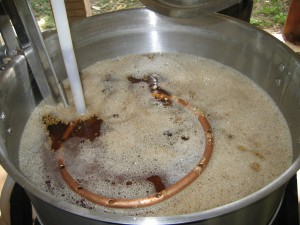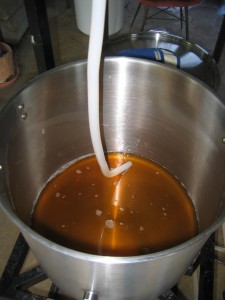Once an all-grain brewer has decided on the malts to use in his or her barleywine, the next thing to consider is the method of wort production. (I covered extract wort production earlier.) Depending on the method you use, you may have to alter your recipe from an initial recipe based on your normal extract efficiency.
Goals
Your goal in wort production is produce a wort at the correct OG and volume, and with a fermentability that can range from middle-of-the-road to fairly high. Hitting your target OG will be easier if you review the elements that contribute to extract efficiency. Crushing the malt finely enough, stirring and performing a mash out all help in this respect. And of course, your method of wort production is also going to influence your extract efficiency based on how much wort you collect from the grain bed.
Fully-Sparged Grain Bed
One way to produce a barleywine wort is to fully sparge the grain bed, collect all the wort you can get from the grains and boil it for an extended period of time. This will evaporate the excess water and reduce the wort to the proper post-boil volume. This is the method used in my Briggs-Haldane Barleywine recipe. Of the methods described here, it exhibits the highest efficiency, but requires the longest boil. To formulate your recipe, just type the grains into your recipe software using your usual extract efficiency. Estimate that you will collect between 0.55 and 0.65 gallons of wort per pound of grain (4.6–5.4 L/kg). On brew day, stop wort collection when the pH of the final runnings climbs above 5.8 (or the gravity falls below SG 1.010).
First Wort Only
Another way to make a barleywine wort is to collect only the first wort and boil that. Since the first wort is at a relatively high specific gravity, your boil time is shortened. However, your extract efficiency is greatly lowered and you’ll need to add extra pale malt to your recipe to compensate for this. To calculate how much extra malt you’ll need, first calculate how much first wort your “normal” recipe will yield. If you have formulated your recipe based on your usual extract efficiency, take the amount of strike water and subtract the amount of water the grains will absorb. This is usually between 0.10 and 0.15 gallons/lb. (0.83–1.25 L/kg). This is the volume of first wort in your mash tun. Subtract this volume of first wort from your target pre-boil wort volume to yield the amount of additional first wort you require. Then add enough pale malt to your recipe to generate this volume of additional first wort. Add pale malt this equation until you hit the correct volume : First wort (gallons) = weight of grain (lb.) * mash thickness (gallons/lb.) – [weight of grain (lb.) * absorbance factor (gallons/lb.)]. To get to mash thickness in gallons per pound from the usual quarts per pound, divide by four. The same equation in metric units is First wort (L) = weight of grain (kg) * mash thickness (L/kg) – [weight of grain (kg) * absorbance factor (L/kg)].
If you make a barleywine from only first wort, you have the option of making a second beer from the leftover wort sugars.
Partially-Sparged Grain Bed
A compromise option is to collect the first wort, then sparge to collect some of the higher gravity wort left in the grain bed, but cut wort collection short when the specific gravity of the runnings starts dropping quickly. In other words, the compromise option is to collect your wort from a partially-sparged grain bed. This results in an extract efficiency between the fully-sparged and first wort options, and also leaves you with some wort sugars to make a second beer with. In addition, the boil time is intermediate between these two methods. This is the method I use for my Hero Barleywine.
Although this method is tempting, estimating the amount of grain required takes a bit of guesswork. The easiest way to do this is to calculate the amount of grain you would need at your normal extract efficiency. Also calculate the amount of wort you would collect if you fully sparked this grain bed. Then, calculate how much extra grain you would have to add if you used the first wort method at your usual pre-boil wort volume. The amount of grain you will need will be intermediate between these two estimates. Figure out how much wort you are going to boil, compare it to the two methods, and scale the amount of grain accordingly. For example, let’s say that for the fully-sparged grain bed, you would need to collect 8 gallons and boil it down to five. With the first wort method, you would need to collect 6 gallons of wort and boil it down to 5. If you plan to collect 7 gallons with the compromise method, this is halfway between the volumes in the other two methods. So, use half of the amount of “extra” pale malt required for the first wort formulation.
Double Fermenter Fill
If the size of your lauter tun, kettle or both prevent you from brewing the volume of barley wine you would like to produce, you can always fill your fermenter in two (or more) shifts. Just scale your recipe down to a size that is workable on your equipment and make your wort at that volume. Then, 16-24 hours later, brew again to make up the volume required.
Malt Extract
Finally, if you see on brewday that you are going to miss your target OG, you can always add malt extract to make up the difference.
Mashing

Mashing out helps with your extract efficiency. This is important when making a barleywine or any other big beer.
On brewday, mashing and wort collection should be straightforward. A single infusion mash, in the 148–153 °F (64–67 °C) range should work under most circumstances. In the upper part of this range, you’ll get a wort with a moderate degree of fermentability. In the lower part of this range , you’ll get a slightly higher degree of fermentability. Let the mash go past the point that you get a negative result in an iodine test. Letting the mash rest for the usual 60 minutes should work well.
Mashing out will help your extract efficiency and make lautering easier if you fly sparge. This is highly recommended when you make a barleywine wort. If you have a mash/lauter tun that can’t be heated, mash in your kettle and scoop the mash over to your lauter tun when the mash is finished. Mashing in your kettle will also allow you to stir the mash and add heat to replace that which is lost when you lift the lid.
In the next installment of this series, we’ll cover boiling and hop additions.
—
Related articles
Wort Production for Very Big Beers
A Very Strong Ale In Three Easy Steps



Great article. This gave me lots to think about as I get ready to brew a barleywine in a month or two for next Christmas. I now have two burners, so I am planning to use some of these techniques to plan the best route.
Great. Good luck with your barleywine.